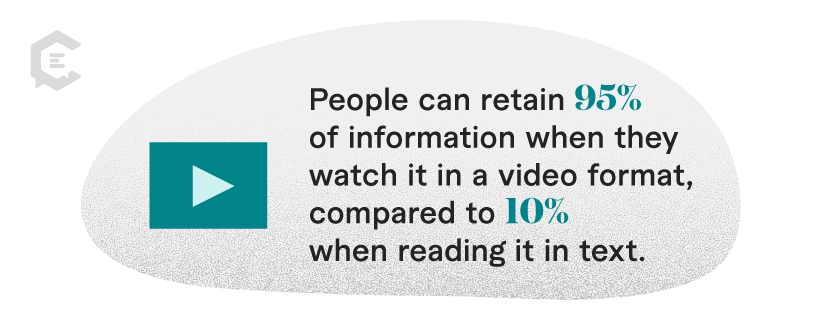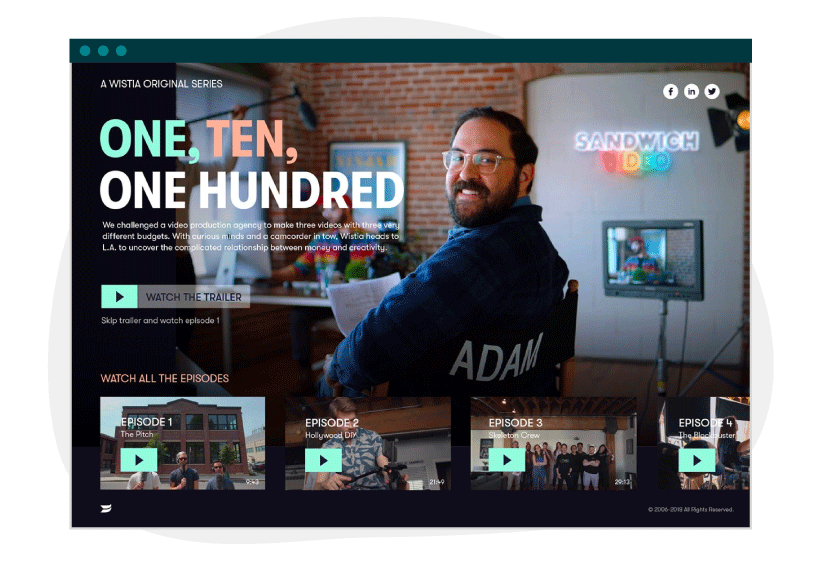We all know about the power of video by now. Ninety-one percent of businesses are using video marketing as a tool. And 9 of 10 consumers say they’d like more brand video content.
But creating impactful video content isn’t just about understanding its importance. It’s also about executing it in an effective and cost-efficient way.
In this article, we’ll break down why video content is a great marketing investment, how to make it more cost-effective, and the most effective strategies for video content distribution.
Why Video Content is a Good Investment
Video content is no longer just a trend. It’s a reflection of how consumers want to receive their information. And with the marketplace as competitive as it is, combined with a decrease in attention spans, it takes eye-catching content to stand out.
Here are all the ways video content can positively affect your marketing efforts:
1. Enhanced Engagement and Retention
If you want to capture and hold your audience’s attention, video is one of the best content types you can use. Insivia’s 2023 Marketing Report found that people can retain 95 percent of information when they watch it in a video format, compared to 10 percent when reading it in text.
By blending visual and audio elements, video content engages multiple senses, making the content more memorable and impactful. That heightens the level of engagement with the viewer, which is crucial in a world where attention is the most valuable currency.
2. Stronger Emotional Connection
We’ve discussed how essential storytelling and emotion are to your content success. Ninety-two percent of people prefer ads presented as a narrative.
Video content can evoke emotions more effectively than most other types of content. Whether it’s a heartwarming story, a funny skit, or an inspiring message, videos can help you quickly connect with audiences on an emotional level. And that creates a stronger bond between your brand and your customers.
3. Increased Conversion Rates
Narrative storytelling doesn’t stop at creating a strong bond. It also boosts conversions by as much as 30 percent. Video content, in general, can dramatically improve conversion rates. Check out these stats:
- Using videos on a landing page can increase conversions by 80 percent (Eye View Digital)
- Companies that use video content achieved a 54 percent higher lead-to-sale conversion rate than those that don’t. (Aberdeen Group)
- 72 percent of people who use video marketing say that video improves their conversion rates. (Wyzowl)
4. Improved SEO Rankings
Google’s algorithms are increasingly prioritizing video content. Embedding videos on your website can improve your search engine ranking, increasing visibility and traffic. One of the ways they do this is by increasing people’s time on your page. A recent study showed website visitors spend over twice as long on pages with video.
5. Versatility and Shareability
The versatility of video content allows it to be used across various platforms – from social media to websites to email campaigns. Videos are also more likely to be shared, expanding the reach of your message. A compelling video can go viral, providing exponential exposure.
6. Catering to Mobile Users
Mobile accounts for 64 percent of digital ad spend, mostly driven by short video apps like TikTok. The majority of people are consuming content on that go. Mobile consumption demands content that is quick to load, easy to digest, and engaging. Short, compelling videos are a great way to engage with users while they’re multitasking or taking a break during their workday.
Having a Cost-effective Mindset with Your Video Content
Vidyard reported that 94 percent of video marketing budgets have remained constant or grown. But do you know what it takes to produce quality video content without blowing your budget?
First, your video marketing strategy should take a 360-degree approach. It’s not about creating one video — it’s about creating as many content assets as possible while keeping their quality. Remember the following when producing your video content to ensure you’re working smart with resources and creative decisions.
1. Think in terms of day rates
Typically, videographers charge a day rate for a film shoot. On a shoot day, fill the schedule to the brim. Capture tons of raw footage so you have more to work with, even if some of the content will be used for a future video project down the road.
2. Provide clear direction with shot lists
A video content project requires a team of creatives. Because of this, everyone will have ideas and methods they prefer. A shot list serves as a checklist that anchors the team, providing clear direction so everyone can work together to achieve the same creative output.
3. Reduce costs with edit decision lists
Where does video get expensive? Usually, in post-production. An edit decision list (EDL) operates similarly to a shot list. The goal is to minimize the back-and-forth process by setting clear expectations about which shots to use and which to ditch.
4. Produce episodic video content
When you’re addicted to a TV series, you binge-watch. Take a cue from Netflix with episodic video content, which is about as cost-effective as you can get with video. You create a video series and keep pressing the button. Episodic video content offers thematic consistency, giving your audience something to get hooked on and look forward to watching again and again.
What can you do in three days of video shooting? Can you create 700 content assets? Yes. Yes, you can. Even if you have a small budget and a big brand story to tell, you can do it as long as your lofty dreams are grounded by video content distribution.
Video Content Distribution: Getting More Mileage
Having content tunnel vision puts you at risk of spending a lot of money on just a few video content assets. Too many marketers blow their budgets on a shiny video or two for their website and call it a day. One of the best ways to maximize your video content’s effect is by implementing a strong content distribution strategy.
Let’s break down where you can put your videos:
Website
Let’s start simple. Of course, your video content should live on your website, but this shouldn’t be its only home. Where you place video content depends on the messaging and CTA. It might work better as a hero background. It might work better in a video resource library. On the flip side, if you have videos stored elsewhere, like YouTube, see if you can repurpose any of that content to be on your website.
Blog
Perhaps the most overlooked part of a video marketing process is the transcription. You see videos in blog posts all the time with no transcribed text below. By transcribing video content, you’re giving the Google robots text to analyze, increasing your content’s SEO value. Rev is a fantastic transcription solution to save you time and resources.
Repurposing video as blog content doesn’t need to be one-to-one either. One video might merit its own blog series. A customer success video can have tons of topics hiding within the responses from the interview. Rather than one transcribed customer success story, how about that, plus three other topically related blog posts?
Content platforms
You don’t have to stop at your blog in the spirit of squeezing everything you can out of your video content. Repurpose your video content on other content publications like Medium and LinkedIn publishing. The import functionality on Medium is an effortless way to repurpose your video blog content, and you won’t get dinged for duplicate content, which is a nice bonus.
Social media
Social media videos should be sliced, diced (and formatted) to appease short attention spans. A/B test to determine how your audience responds to messaging, horizontal vs. vertical, or length. Do your LinkedIn followers prefer 1-minute or 8-minute videos? And note that native videos perform better across the board than posting YouTube video links.
Speaking of YouTube, it’s a bit of a unicorn in this equation. It’s social media, but it’s also a content platform in its own right. If you decide to make episodic video content, you can build out this channel and build up an audience of subscribers. To ensure your videos are seen on YouTube, optimize like crazy — and, of course — cross-promote on other channels.
Landing Pages
Your landing page is a conversion driver, so it’s a great place to have a powerful video centerstage. It sets the tone for a customer’s entire experience with your brand. Whether it’s an explainer video, a product demo, or a brand story, a well-crafted video can provide a quick, immersive understanding of your product or service. Then, it can encourage viewers to take the next step in their customer journey.
Ready to Create Captivating Video Content?
The great Ann Handley of MarketingProfs once said: “Quality content means content that is packed with clear utility and brimming with inspiration while having relentless empathy for the audience.”
Now that you know why video content is vital and how it can be strategically used across various platforms, the next step is to start creating. Whether you need one video or one thousand, ClearVoice is happy to help. Our managed content creation and expert creators can help you produce high-quality videos that capture your audience’s attention.
Talk to one of our strategists today to get started.








